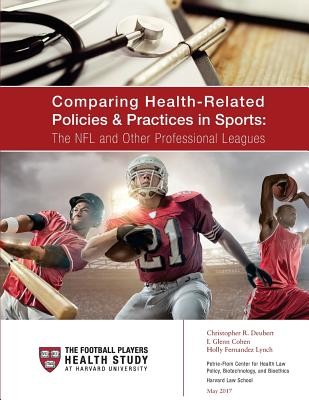
- We will send in 10–14 business days.
- Author: I Glenn Cohen
- Publisher: CreateSpace Independent Publishing Platform
- Year: 2017
- Pages: 256
- ISBN-10: 1546516743
- ISBN-13: 9781546516743
- Format: 21.6 x 27.9 x 1.4 cm, softcover
- Language: English
- SAVE -10% with code: EXTRA
Comparing Health-Related Policies & Practices in Sports (e-book) (used book) | bookbook.eu
Reviews
Description
This comprehensive report, published as part of the Football Players Health Study at Harvard University, highlights areas in which the player health related policies and practices of the NFL could potentially be improved by considering steps taken by other professional sports leagues. While the report concludes that the NFL's player health provisions are generally the most protective of player health among the relevant comparators, there are still important opportunities for improvement. The report is unprecedented both in scope and focus. This is the first comprehensive comparison of the health-related policies and practices of elite professional sports leagues: the National Football League (NFL); Major League Baseball (MLB); National Basketball Association (NBA); National Hockey League (NHL); Canadian Football League (CFL); and, Major League Soccer (MLS). After analyzing the leagues, the report compares each one to the NFL on the following health-related issues: (1) Club Medical Personnel (including discussion of conflicts of interest); (2) Injury Rates and Policies (including detailed comparisons of concussion rates); (3) Health-Related Benefits (including health insurance and retirement benefits for current and former players); (4) Drug and Performance-Enhancing Substance Policies; (5) Compensation (including guaranteed compensation); and, (6) Eligibility Rules (including discussion of the "readiness" of athletes for professional play). The areas in which the NFL can potentially learn from other leagues are: 1. Pre-season physicals performed by a neutral physician (CFL). 2. Concussion-specific short-term injury list (MLB). 3. Injury reporting policies that do not require disclosure of the location of a player's injury (MLB, NHL, and CFL). 4. Health insurance to players for life (MLB, NBA, and NHL). 5. Retirement plan payments higher than the NFL (MLB, NBA, and NHL). 6. Players vested in pension plans on their first day in the league (MLB and NHL). 7. Treatment for players who violated performance-enhancing substance policies (NBA and CFL). 8. More guaranteed compensation than in the NFL (MLB, NBA, and NHL). 9. Less restrictive eligibility rules (MLB, NBA, NHL, and MLS).
- Author: I Glenn Cohen
- Publisher: CreateSpace Independent Publishing Platform
- Year: 2017
- Pages: 256
- ISBN-10: 1546516743
- ISBN-13: 9781546516743
- Format: 21.6 x 27.9 x 1.4 cm, softcover
- Language: English English
This comprehensive report, published as part of the Football Players Health Study at Harvard University, highlights areas in which the player health related policies and practices of the NFL could potentially be improved by considering steps taken by other professional sports leagues. While the report concludes that the NFL's player health provisions are generally the most protective of player health among the relevant comparators, there are still important opportunities for improvement. The report is unprecedented both in scope and focus. This is the first comprehensive comparison of the health-related policies and practices of elite professional sports leagues: the National Football League (NFL); Major League Baseball (MLB); National Basketball Association (NBA); National Hockey League (NHL); Canadian Football League (CFL); and, Major League Soccer (MLS). After analyzing the leagues, the report compares each one to the NFL on the following health-related issues: (1) Club Medical Personnel (including discussion of conflicts of interest); (2) Injury Rates and Policies (including detailed comparisons of concussion rates); (3) Health-Related Benefits (including health insurance and retirement benefits for current and former players); (4) Drug and Performance-Enhancing Substance Policies; (5) Compensation (including guaranteed compensation); and, (6) Eligibility Rules (including discussion of the "readiness" of athletes for professional play). The areas in which the NFL can potentially learn from other leagues are: 1. Pre-season physicals performed by a neutral physician (CFL). 2. Concussion-specific short-term injury list (MLB). 3. Injury reporting policies that do not require disclosure of the location of a player's injury (MLB, NHL, and CFL). 4. Health insurance to players for life (MLB, NBA, and NHL). 5. Retirement plan payments higher than the NFL (MLB, NBA, and NHL). 6. Players vested in pension plans on their first day in the league (MLB and NHL). 7. Treatment for players who violated performance-enhancing substance policies (NBA and CFL). 8. More guaranteed compensation than in the NFL (MLB, NBA, and NHL). 9. Less restrictive eligibility rules (MLB, NBA, NHL, and MLS).


Reviews